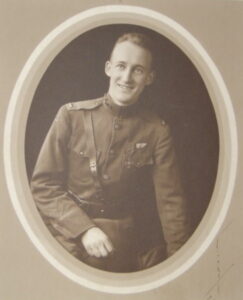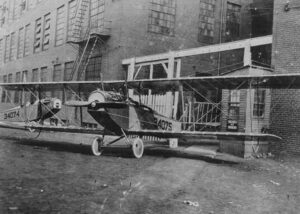 In World War I, airplanes were a relatively new item. The Wright brothers made their first sustained flight on December 17, 1903, so by 1918, they were still barely more than a novelty, but that didn’t matter. The world needed these machines, if the Allied countries were to win World War I. I’m sure that no one really knew how these new machines were going to work out, and I can only imagine how the pilots that had to fly those first planes felt about not only flying in them, but doing combat in them. One of those first crew members was Stephen W Thompson, a 24-year-old gunner on a French aircraft in February 1918.
In World War I, airplanes were a relatively new item. The Wright brothers made their first sustained flight on December 17, 1903, so by 1918, they were still barely more than a novelty, but that didn’t matter. The world needed these machines, if the Allied countries were to win World War I. I’m sure that no one really knew how these new machines were going to work out, and I can only imagine how the pilots that had to fly those first planes felt about not only flying in them, but doing combat in them. One of those first crew members was Stephen W Thompson, a 24-year-old gunner on a French aircraft in February 1918.
Thompson was born on March 20, 1894, in West Plains, Missouri. When the United States entered World War I in April 1917, Thompson was a senior in electrical engineering at the University of Missouri. Men were needed to go and fight, so the school announced that seniors who joined the military before graduation would receive their diplomas in June. Being a loyal American, Thompson enlisted in the Army. He was sent for basic training at Fort Riley, Kansas, and by June he was sent to Fort Monroe, Virginia for training in the Coast Artillery Corps. The train ride to his post would change his life forever, when he spotted an airplane in the sky. It was the first one he had ever seen, and when he got the opportunity, he went to the flying field, the Curtis School at Newport News, and asked if he could take a ride. He figured it might be the only chance he would get, and he didn’t want to miss out. Thomas Scott Baldwin, who had been a famous performer in his own balloons and dirigibles, was in charge and he agreed to give Thompson a ride. The plane  was a Curtiss JN-4 Jenny and the pilot was Edward Stinson, a prominent flyer at the time who later founded the Stinson Aircraft Company.
was a Curtiss JN-4 Jenny and the pilot was Edward Stinson, a prominent flyer at the time who later founded the Stinson Aircraft Company.
After his ride, in which Stinson did a number of aerobatic maneuvers, including looping the loop five times in a row, Thompson said that the only thing that kept him from falling out of the plane at the top of the last loop was the lap belt. I can only imagine how he felt, but that flight changed Thompson’s whole life. He decided to apply for duty in the Air Service. He was accepted, and on February 5, 1918, flying as a gunner on a French aircraft in February 1918, he became the first member of the United States military to shoot down an enemy aircraft. He was not the first person to shoot down another aircraft, because Kiffin Rockwell achieved an earlier aerial victory as an American volunteer member of the French Lafayette Escadrille in 1916. Nevertheless, Thompson was the first “official soldier” to do so. That day, the 1st Aero Squadron had not yet begun combat operations, and Thompson visited a French unit with a fellow member of the 1st Aero Squadron. The men were invited to fly as gunner-bombardiers with the French on a bombing raid over Saarbrücken, Germany. Well, nobody had to ask them twice. The run was successful, but after they had dropped their bombs, the squadron was attacked by Albatros D III fighters. Immediately taking action, Thompson shot down one of them, thereby  carrying out the first aerial victory by any member of the US military. He was awarded the Croix de Guerre with Palm for the action.
carrying out the first aerial victory by any member of the US military. He was awarded the Croix de Guerre with Palm for the action.
After the war Thompson worked at McCook Field for several years as an engineer. Today, McCook Field is Wright-Patterson Air Force Base. Following his time at McCook Field, he became a high school mathematics teacher. During World War II, he taught preflight and meteorology. He maintained an interest in aviation and in 1940 he received US Patent Number 2,210,642 for a tailless flying wing. He died on October 9, 1977, in Dayton, Ohio at age 83.


Leave a Reply